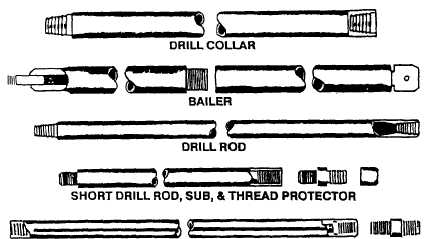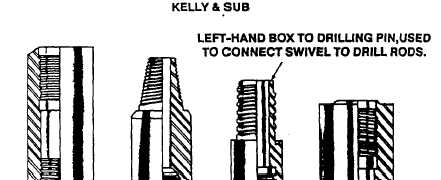collar (fig. 9-9) joins the bits and drill pipe and helps
stabilize the bit and keeps the hole uniform and straight.
This collar is 10 feet long and has a diameter larger than
that of the drill pipe, yet small enough to clear the wall
of the hole. The kelly sub, or wear sub, connects the
kelly to the drill pipe. When it becomes worn, it can be
changed instead of the entire kelly.
In areas where surface formations are soft or sandy,
it is necessary to set the casing to keep the walls of the
hole from caving and to prevent the hole from being
enlarged by the washing action of the circulating fluid.
Sometimes, the hole is reamed or enlarged to set the
casing on a firm foundation. To run the casing, you
should attach a sub to the hoisting plug and threaded into
a length of the casing. Some casings are not threaded
and must be welded together. The welded casing can be
washed and cooled down by the mixing hose from the
mud pump and then run into the hole in the same manner
as the drill pipe. If the hole has caved so the casing will
not go down, attach the swivel to the casing with a sub
and circulate fluid through the casing. This is called
washing down and is sometimes used to wash the casing
to the bottom of a caving hole.
The kelly and drill pipe are hollow to allow fluid
mixtures of clay and water, air, foam, and so forth, to be
pumped through them to the bit. The fluid circulates
through the drill pipe and out through the bit, where it
sweeps under the bit and picks up the material loosened
by it. It then carries the material to the surface through
the space between the drill pipe and walls of the well.
Fluid from the well overflows into a ditch and passes
into a settling pit, where the cuttings settle. The fluid
free from coarse material and containing only
fine-grained clay in suspension, flows into another pit
and is picked up by the pump for recirculation in the
well.
Enough mud-laden fluid (drilling mud) must be
circulated to cool and clean the cutting tool properly and
to rise in the hole fast enough to carry the cuttings with
it. The weight and viscosity of the fluid, aided by the
Figure 9-9.-Drill steel, collars, and subs.
9-8





